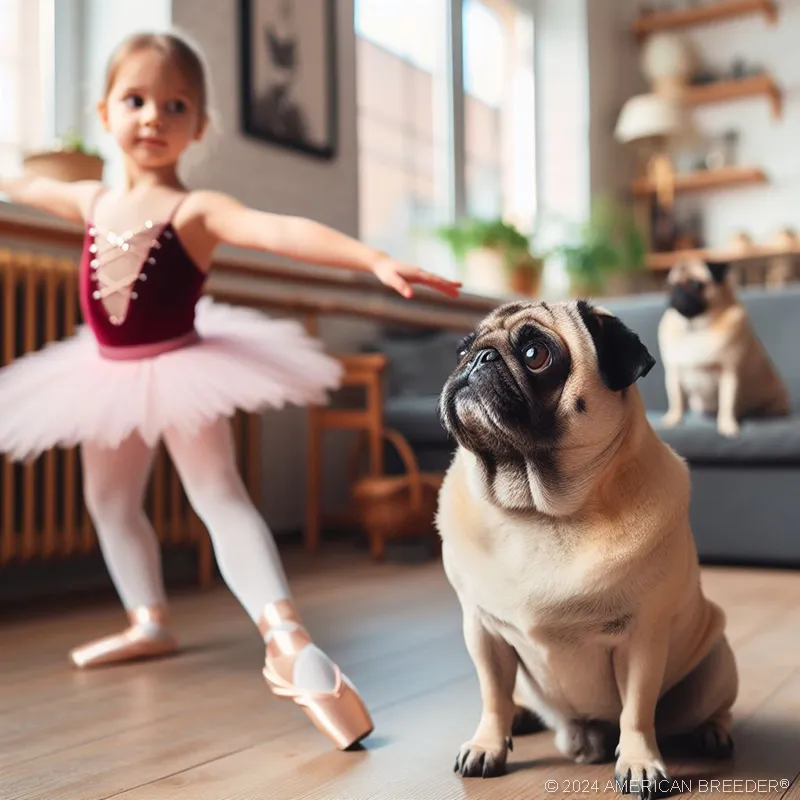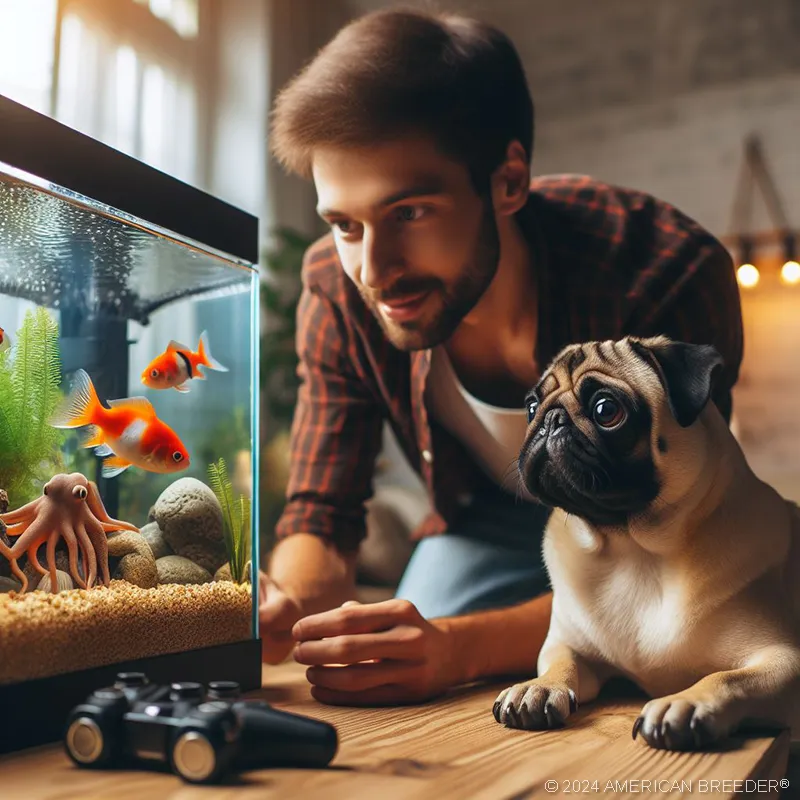Your Ultimate Journey into the World of Pugs
Introduction
 Pugs, often lovingly referred to as the "clowns" of the canine world, captivate the hearts of dog lovers with their endearing personalities and unique appearance. Their large, soulful eyes and signature wrinkled faces are testaments to their charm. Beyond their physical
Pugs, often lovingly referred to as the "clowns" of the canine world, captivate the hearts of dog lovers with their endearing personalities and unique appearance. Their large, soulful eyes and signature wrinkled faces are testaments to their charm. Beyond their physical
attributes, Pugs are known for their playful and affectionate nature, making them ideal companions for families, singles, and seniors alike.
Pugs boast a rich history that traces back to ancient China, where they were treasured companions of Chinese royalty. These dogs were highly regarded and even had their own dedicated living quarters in the palaces. Their lineage contributes to their regal demeanor and preference for being pampered and surrounded by human company.
When considering adding a Pug to your family, it's important to understand that their distinct physical features, such as their short muzzle, contribute to brachycephalic syndrome, which can lead to breathing difficulties and heat intolerance. Consequently, it's crucial to be mindful of their comfort in hot and humid weather, ensuring they have access to shade and water.
Bringing a Pug into your life means embracing their penchant for attention and affection. Pugs are renowned for their social nature and thrive when they're a central part of the family dynamic. Their engaging personality and love for companionship make them delightful additions to households of all sizes.
Origin and History
The history of the Pug is a tapestry woven with threads of culture, royalty, and companionship. Originating in ancient China, Pugs were cherished by emperors and nobles for their charming personalities and loyal disposition. These dogs were often pampered and even had their own servants dedicated to their care. The Pug's journey continued as they made their way to Europe, where they found favor with royal families and became beloved members of European courts. As Pugs made their way to Europe in the 16th century, they quickly captured the hearts of the elite, including Queen Victoria of England, who was a devoted Pug enthusiast. Their popularity spread across the continent, with Pugs becoming symbols of luxury and status.
 In the modern era, Pugs have maintained their popularity, captivating people with their charismatic nature and distinctive appearance. They've transitioned from being companions of royalty to beloved family pets, winning over households with their affectionate behavior and endearing antics. Throughout their history, Pugs have retained their special bond with humans. This bond, cultivated over centuries, has solidified them as dogs that thrive on human companionship and interaction. Their legacy as loyal companions has left an indelible mark on the hearts of dog lovers around the world.
In the modern era, Pugs have maintained their popularity, captivating people with their charismatic nature and distinctive appearance. They've transitioned from being companions of royalty to beloved family pets, winning over households with their affectionate behavior and endearing antics. Throughout their history, Pugs have retained their special bond with humans. This bond, cultivated over centuries, has solidified them as dogs that thrive on human companionship and interaction. Their legacy as loyal companions has left an indelible mark on the hearts of dog lovers around the world.
Understanding the Pug's Characteristics
Pugs are a breed of paradoxes—small in size yet large in personality, gentle in nature yet fiercely loyal. Their compact build and sturdy frame make them adaptable to various living environments, from apartments to larger homes with yards. Their signature wrinkled faces and expressive eyes offer a window into their emotions, while their wagging tails and joyful demeanor reflect their playful spirit.
While Pugs' adorable appearance is undoubtedly captivating, it's important to be aware of potential health considerations associated with their distinctive features. Their short muzzle can contribute to brachycephalic syndrome, impacting their breathing and heat tolerance. Regular monitoring, awareness of temperature conditions, and measures to keep them cool and comfortable are essential for their well-being.
Pugs' playful nature and boundless energy make them wonderful companions for families with children. Their gentle disposition allows them to form strong bonds with kids, providing endless opportunities for shared fun and adventure. Teaching children to treat Pugs with care and respect fosters a harmonious and loving relationship.
When it comes to coat care, Pugs' short coats are relatively low-maintenance in terms of grooming. However, their facial wrinkles require special attention to prevent skin issues. Regular cleaning and drying of the wrinkles can help prevent moisture buildup and potential infections, ensuring your Pug remains healthy and comfortable.
Pug's Temperament and Behavior
 The Pug's temperament is a blend of affection, playfulness, and a touch of mischievousness. Their outgoing nature makes them social butterflies, often seeking out the company of both humans and other pets. Pugs thrive on attention and are known for forming strong bonds with their families.
The Pug's temperament is a blend of affection, playfulness, and a touch of mischievousness. Their outgoing nature makes them social butterflies, often seeking out the company of both humans and other pets. Pugs thrive on attention and are known for forming strong bonds with their families.
Pugs' eagerness to please their owners is a cornerstone of their temperament. This willingness to cooperate can be harnessed for positive reinforcement training, making them responsive learners. Utilizing rewards-based training methods, such as treats and praise, can help you shape your Pug's behavior effectively.
However, it's important to be mindful of their occasional stubborn streak. Pugs have a knack for asserting their own preferences, particularly if they believe they can get away with it. Consistent training and establishing clear boundaries from an early age can help prevent behavioral challenges down the road.
While Pugs are generally friendly and sociable, early socialization remains crucial. Exposing them to various people, environments, and experiences helps them develop confidence and adaptability. It also plays a role in preventing shyness or fear-based behaviors as they grow.
Exercise and Activity Needs
Pugs are spirited little dogs with a surprising amount of energy packed into their small frames. Their playful nature makes daily exercise essential to prevent boredom and maintain their overall well-being. While they may not be marathon runners, Pugs thrive on engaging activities that cater to their unique strengths and interests.
Despite their smaller size, Pugs have a surprising amount of stamina, especially when it comes to playtime. Engaging them in interactive games like fetch, puzzle toys, and hide-and-seek can provide both physical exercise and mental stimulation. These activities tap into their curious nature and help keep their minds sharp.
 While Pugs enjoy outdoor activities, it's important to be mindful of their sensitivity to temperature. Their short snouts make them prone to overheating in hot weather, so aim for walks and play sessions during cooler parts of the day. In colder weather, provide them with cozy attire to keep them comfortable.
While Pugs enjoy outdoor activities, it's important to be mindful of their sensitivity to temperature. Their short snouts make them prone to overheating in hot weather, so aim for walks and play sessions during cooler parts of the day. In colder weather, provide them with cozy attire to keep them comfortable.
Indoor activities can also cater to a Pug's exercise needs. Setting up an obstacle course or teaching them new tricks not only burns energy but also strengthens the bond between you and your Pug. Consider agility training, which allows them to navigate through tunnels and over jumps, harnessing their natural agility and enthusiasm.
Health and Care of Pug Dogs
Ensuring the well-being of your Pug involves a combination of regular veterinary care, proper grooming, and preventive measures. Their unique anatomy calls for special attention to certain aspects of their health, including respiratory function and skin care.
Regular veterinary check-ups are crucial for Pugs, as they can help identify and address potential health issues early on. Be sure to work closely with a veterinarian experienced in brachycephalic breeds to monitor their respiratory health and address any concerns promptly.
Pugs' skin folds, particularly those on their faces, require careful cleaning to prevent irritation and infection. Using a damp cloth to gently wipe the folds and keeping them dry can help prevent issues caused by moisture buildup. Regular ear cleaning and nail trimming are also important aspects of their grooming routine.
Given their susceptibility to obesity, maintaining a balanced diet is vital for Pugs. Providing them with high-quality, portion-controlled meals can help prevent weight gain and related health issues. Consult your veterinarian for guidance on the best diet and feeding schedule for your Pug's individual needs.
Socialization and Training
Socializing and training a Pug is a journey that contributes to their well-rounded personality and behavior. Early exposure to various environments, people, and animals helps them develop the confidence and social skills necessary for a fulfilling life.
 Pugs' social nature makes them generally amiable towards other pets and humans. Properly introducing them to new animals and teaching them positive behaviors during interactions sets the stage for harmonious relationships. Puppy classes and group training sessions can also provide structured socialization opportunities.
Pugs' social nature makes them generally amiable towards other pets and humans. Properly introducing them to new animals and teaching them positive behaviors during interactions sets the stage for harmonious relationships. Puppy classes and group training sessions can also provide structured socialization opportunities.
Training Pugs should focus on positive reinforcement methods that emphasize rewards and encouragement. Pugs respond well to treats, praise, and play as incentives for good behavior. Their desire to please their owners combined with consistent training efforts lays the foundation for a well-behaved and enjoyable companion.
Keep in mind that Pugs have a penchant for following their noses, which can lead to wandering or even bolting out of excitement. A reliable recall command and leash training are essential to ensure their safety during outdoor adventures. As you train your Pug, remember that patience, consistency, and positive reinforcement are key.
Living with a Pug: Lifestyle Considerations
Welcoming a Pug into your home involves making adjustments to accommodate their unique needs and characteristics. From living arrangements to daily routines, creating an environment where your Pug thrives requires careful consideration.
Pugs' adaptable size and moderate exercise needs make them suitable for various living arrangements. They can thrive in apartments with regular outdoor walks or enjoy the benefits of a backyard in suburban or rural settings. Regardless of your living situation, ensuring they have ample opportunities for play and mental stimulation is essential.
Their social nature makes Pugs prone to separation anxiety if left alone for extended periods. Creating a routine that includes quality time together, mental enrichment activities, and interactive toys can help alleviate their anxiety and keep them content when you're away.
 When it comes to traveling with a Pug, planning ahead is key. Their sensitivity to temperature requires careful consideration during road trips or flights. Be sure to provide them with a comfortable and secure travel carrier, plenty of water, and scheduled breaks to stretch their legs and relieve themselves.
When it comes to traveling with a Pug, planning ahead is key. Their sensitivity to temperature requires careful consideration during road trips or flights. Be sure to provide them with a comfortable and secure travel carrier, plenty of water, and scheduled breaks to stretch their legs and relieve themselves.
Pug's Enduring Legacy
The Pug's legacy is one of charm, loyalty, and the ability to weave themselves into the hearts of those who share their lives. From ancient palaces to modern homes, Pugs continue to bring joy, companionship, and a touch of whimsy to people across the globe.
Pugs have found their way into art, literature, and popular culture throughout history. Their unmistakable appearance and endearing behaviors have made them beloved subjects in paintings, books, and even movies. This enduring presence is a testament to their captivating nature.
Their legacy isn't confined to the past; Pugs continue to leave their mark on the world today. They participate in dog sports, therapy work, and community events, showcasing their adaptability and versatility. Their boundless affection and unwavering loyalty ensure that their legacy as cherished companions will endure for generations to come.
Conclusion
The journey through the world of Pug dogs is one of discovery, compassion, and endless affection. By understanding their origins, embracing their unique characteristics, and providing responsible care, you'll be rewarded with a loyal and loving companion who enriches your life in countless ways. As you embark on this journey, remember that the bond you form with your Pug is a reflection of the deep connection between humans and their canine companions—a bond that transcends time and brings immeasurable joy and fulfillment.
Pug Dog Quick Reference Guide
Breed Background: Origin: China | Breed Purpose: Companion | AKC Class: Toy | Year Recognized by AKC: 1885 Appearance: Size: Small | Weight: 14-18 pounds | Coat Type: Short and smooth | Colors & Patterns: Fawn, black | Distinctive Features: Wrinkled face, curled tail
Appearance: Size: Small | Weight: 14-18 pounds | Coat Type: Short and smooth | Colors & Patterns: Fawn, black | Distinctive Features: Wrinkled face, curled tail
Temperament: Energy Level: 3/5 | Loyalty: 4/5 | Friendliness to Pets: 4/5 | Friendliness to Strangers: 4/5 | Trainability: 3/5 | Playfulness: 5/5 | Frequent Barker: 3/5 | Chase Instincts: 2/5 | Sense of Smell: 3/5 | Drive to Hunt: 2/5
Health & Care: Health Issues: Brachycephalic syndrome, eye problems | Lifespan: 12-15 years | Grooming Difficulty: Low | Exercise Needs: Moderate
Socialization: Interaction with Children: Good, playful | Interaction with Pets: Generally good | Interaction with Strangers: Friendly | Elderly Compatibility: Excellent | Ease of Training: Moderate
Suitable Living Arrangements: Apartment: Yes | House: Yes | Rural Area: No | Yard Size Requirements: Small yard or regular walks
Training & Obedience: Trainability: 3/5 | Intelligence: 3/5 | Obedience: 3/5 | Problem-Solving: 2/5 | Easily Stimulated: 4/5 | Focus Level: 3/5 | Easily Distracted: 3/5
Financial Planning: Typical Price Range: $600 - $2,500 | Initial Expenses: Basic supplies, puppy vaccinations | Ongoing Annual Expenses: Food, medical checkups
Breeding: Reproductive Maturity: 6-8 months | Litter Frequency: 1-2 litters per year | Litter Size: 2-4 puppies | Stud Cost: $500 - $1,500 | Breeding Challenges: Caesarean births are common due to their head size
Did You Enjoy this Article? Share it and Help Us Spread the Word!
If you found this article helpful, we'd appreciate it if you could share it with your friends or link to it from your website, blog, or group! You can also use the convenient social share tabs on the left side of the screen to instantly share this page to your social media feed. For more ways to support and promote the American Breeder Community, visit our Share & Promote Together page for social media posts and memes you can copy and share. Your support means the world to us!
Disclaimer: The information provided in this article is for general informational purposes only and does not constitute legal, medical, financial, or professional advice. While we strive for accuracy, we make no representations or warranties regarding the completeness, accuracy, reliability, or suitability of the information. Please consult with a professional before making decisions based on the content provided. American Breeder Inc. assumes no responsibility for any errors or omissions or for the results obtained from the use of this information.
